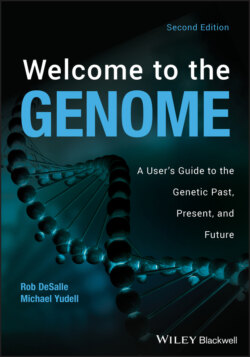Читать книгу Welcome to the Genome - Michael Yudell - Страница 26
RESEARCH MILESTONE 5: COPYING DNA
ОглавлениеDuring the 1970s scientists improved upon the Southern blot and other gel electrophoresis methods. Southern’s method required a tremendous amount of DNA and thus a tremendous amount of laboratory labor. It also lacked the precision to see the location of individual bases. To get around this shortcoming, scientists developed methods to amplify or clone (meaning simply to copy) DNA.
Found in bacteria, the small, circular extrachromosomal DNA molecule known as a plasmid often times carries genes that confer antibiotic resistance to bacteria. Under normal conditions a plasmid can facilitate genetic exchange between different bacterial strains: A gene fragment from one bacterium is carried to and inserted into a chromosome by a plasmid. In 1973 scientists discovered that if you biochemically insert a target stretch of DNA into a plasmid and put the plasmid into a bacterial cell, such a cell makes thousands and perhaps millions of copies of the plasmid and hence the attached DNA. (28) This procedure, incorporated into sequencing technology, made it easier to make large amounts of a desired stretch of DNA. There are, however, two serious shortcomings of the use of plasmids. First, bacterial plasmids must be cultured. This is time‐consuming. Second, plasmids can take up only a small piece of DNA efficiently. If the DNA stretch picked up by a plasmid is too large, the plasmid is unable to make accurate copies.
Since the discovery of plasmids or what might be termed bacterial copying machines, other vehicles have been created that can copy larger pieces of DNA. The average limiting size of a plasmid is about 5000 bases. Phages, a specific class of viruses that infect bacteria and can be stably replicated by them, can carry about 15,000 bases; cosmids, an artificial cloning vector with a phage gene, can carry about 35,000 bases; bacterial artificial chromosomes (also known as BACs) can take over 100,000 bases of sequence; and yeast artificial chromosomes (also known as YACs) can take approximately 1,000,000. Although these microbial methods remain an important component of DNA sequencing and were central to the effort to sequence the human genome, they are all arduous ways to copy DNA. BAC‐copied DNA was used in the sequencing of the human genome. (29)
